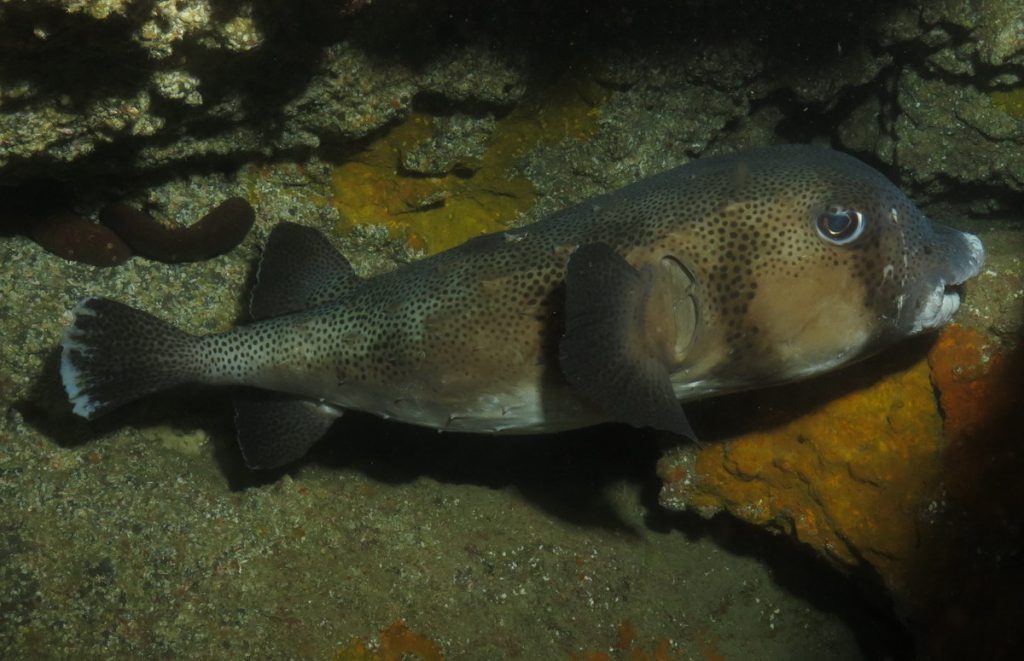
For over ten years, my instructors at Davy Jones Diving have been recording the ‘special sightings’ every day from their dives in the El Cabrón Marine Reserve. Sightings of marine life that we believe are less common or more special, such as seahorses, angel sharks, rays, or barred hogfish all get recorded and displayed online. The data is also saved in a simple text database so you can compare easily sightings from one year or month to another.
This data has been used in the past by scientists from the University of Las Palmas de Gran Canaria (ULPGC) to study the frequency and timing of angel shark visits to the marine reserve. This contributed to a better understanding of the behaviour patterns and highlighted two peaks, one in December and another in late spring (May/June).
This ‘Citizen Science database’ has now been used in a second study, which has been looking at the population of the Spotfin Burrfish, locally known as Tamboril espinoso or Spiny Pufferfish ( Chilomycterus reticulatus ) in Gran Canaria. When combined with data from other sources including interviews with dive centres and specialists, the scientists in the Faculty of Marine Sciences at ULPGC have confirmed that the population of the Spiny Pufferfish has been increasing with encounters by recreational scuba divers on Gran Canaria becoming more frequent.

The Spiny pufferfish is officially protected in the Canary Islands where it appears on the list of ‘Protected Species of the Canary Islands’ and is officially classified as Vulnerable.
While the species has no commercial value within the fishing industry, it is usually highly regarded by recreational scuba divers, as despite its large size, it can be slow moving and cautious when encountered in crevices and small caves. Unlike fast moving species such as bonito and garrickfish, you can get a good look at it, and it makes a great photographic subject.
The study by the ULPGC looked at how the range of the spiny pufferfish has increased over the last few years on the islands of Gran Canaria and el Hierro. By comparing the sightings in both Islands they have shown that as water temperatures have increased in Gran Canaria over the last ten years, the sightings of the spiny pufferfish have also increased.
This reflects our own experience in Arinaga where ten years ago (2009/2010) we probably found the Spiny Pufferfish on only 3 or 4 dives per year. During the last four years the frequency of sightings have gone right up. There are now some individuals who seem to have their own personal refuge, and can be found there almost on a daily basis. There are also some more mature individuals who can be found on a regular (but not daily) basis in a series of special corners and hiding places.
Identifying Members of the population


The other aspect of our citizen science is that we have been able to identify individuals by differences in their colour, anatomy and facial patterns. This came about when we realised that one individual had an easily recogniseable ‘bad back’ which gives him a different profile in his body. When we then examined some of the photographs of other individuals we identified that the facial patterns are very individual, and can be used to ‘name’ different individuals.

More recently we have seen one spiny pufferfish that has a distinctive bite mark on his right pectoral fin.. but also has a body colour which in the photographs and natural light is much more ‘blue’ than other individuals, who tend to be more of a brown colour.


The growth in the population of the Spiny Pufferfish in the El Cabrón marine reserve has been one of the diving ‘good news’ stories of the last ten years, accompanied at the same time by the growth in numbers of abade, dusky grouper and other species. Recreational divers in Gran Canaria are now able to see this species on a more regular basis and experience a contact with a gentle giant of the canarian eco-system.
As the population of this species is vulnerable we do not publish the exact locations, so If you want to see these and other endangered species of the Canary Islands or see the variety of other dive sites in Gran Canaria then get in touch with us, and we can help plan your diving in Gran Canaria so that you see some of these incredible creatures.
Author – Brian Goldthorpe is a BSAC Advanced Instructor and a PADI Master Scuba Diver Trainer with ‘Elite’ status. He has been diving in the Canary Islands since 2002 where he runs a diving centre in Gran Canaria – Davy Jones Diving , where in between his Radio, TV and Press appearances Eduardo also shows guests around the El Cabrón Marine Reserve.
